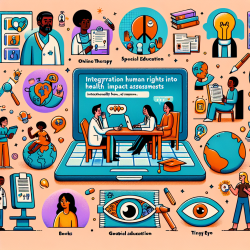Health Impact Assessments (HIAs) are crucial tools used to predict the health consequences of proposed policies, programs, and projects. However, integrating human rights into these assessments can significantly enhance their effectiveness and legitimacy. The research article "The Value of Mainstreaming Human Rights into Health Impact Assessment" provides a compelling argument for this integration, offering valuable insights for practitioners.
Why Integrate Human Rights into HIAs?
The integration of human rights into HIAs brings several advantages:
- Universal Value System: Human rights provide a universally accepted set of values and standards, ensuring that HIAs are grounded in ethical and legal principles recognized globally.
- Legal Obligations: Many countries have legal obligations under international human rights treaties, which can be reinforced through human rights-based HIAs.
- Accountability: Human rights frameworks include mechanisms for holding governments accountable, which can enhance the transparency and legitimacy of HIAs.
- Focus on Vulnerable Groups: Human rights emphasize the protection of vulnerable populations, ensuring that HIAs address equity and nondiscrimination.
Steps to Integrate Human Rights into HIAs
Integrating human rights into HIAs involves several key steps:
1. Screening
Examine the government's legal obligations regarding the right to health to determine whether a full HIA is warranted.
2. Scoping
Educate affected populations about their right to health and their right to participate in the HIA. Ensure that the research questions and analysis plan are based on a human rights framework.
3. Data Collection
Involve marginalized and disadvantaged groups in the data collection process, paying particular attention to their concerns.
4. Analysis
Analyze the evidence collected against the government's human rights obligations, and make recommendations based on their potential to contribute to the full realization of the right to health.
5. Reporting
Provide a human rights rationale for the recommendations, outlining the best options for the government to fulfill its human rights obligations.
6. Monitoring and Evaluation
Include mechanisms for stakeholder participation in the ongoing monitoring and evaluation of the policy or program, and establish ways for stakeholders to bring complaints about impacts on their right to health.
Benefits of a Human Rights Framework
Integrating human rights into HIAs offers numerous benefits:
- Legitimacy: Human rights are widely accepted and provide a legitimate basis for decision-making.
- Legal Framework: Human rights obligations can legally mandate the conduct of HIAs, particularly in contexts like international trade negotiations.
- Coherence: A human rights framework applies across all government sectors, promoting policy coherence.
- Ethical Principles: Principles like participation, equality, and nondiscrimination are not just good practices but legal obligations under human rights law.
- Empowerment: Human rights frameworks empower communities and individuals to claim their rights and hold governments accountable.
Conclusion
Integrating human rights into HIAs not only enhances the ethical and legal grounding of these assessments but also ensures that they are more inclusive, transparent, and accountable. Practitioners are encouraged to adopt this approach to improve the quality and legitimacy of their HIAs.To read the original research paper, please follow this link:
The Value of Mainstreaming Human Rights into Health Impact Assessment.










